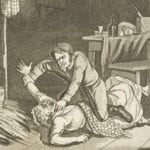 Weird Stuff
Weird Stuff  Weird Stuff
Weird Stuff  Mysteries
Mysteries 10 Tragic Disappearances and Deaths in Joshua Tree National Park
 History
History 10 Ways Childhood Really Sucked in the Old West
 Music
Music 10 Name Origins of Famous Bands from the 1990s
 Religion
Religion 10 Biggest Turnarounds by the Catholic Church
 Weird Stuff
Weird Stuff 10 Unbelievable Times Laws Had Unintended Consequences
 Humans
Humans Ten Historic Women Who Deserve Way More Credit Than They Got
 Movies and TV
Movies and TV 10 Films That Spawned Major Lawsuits
 History
History Ten Times Towns Were Wiped Off the Face of the Earth
 Creepy
Creepy 10 of the Most Disturbingly Haunted Public Houses in the UK
 Weird Stuff
Weird Stuff 10 Niche Subcultures That Are More Popular Than You Might Think
 Mysteries
Mysteries 10 Tragic Disappearances and Deaths in Joshua Tree National Park
 History
History 10 Ways Childhood Really Sucked in the Old West
Who's Behind Listverse?

Jamie Frater
Head Editor
Jamie founded Listverse due to an insatiable desire to share fascinating, obscure, and bizarre facts. He has been a guest speaker on numerous national radio and television stations and is a five time published author.
More About Us Music
Music 10 Name Origins of Famous Bands from the 1990s
 Religion
Religion 10 Biggest Turnarounds by the Catholic Church
 Weird Stuff
Weird Stuff 10 Unbelievable Times Laws Had Unintended Consequences
 Humans
Humans Ten Historic Women Who Deserve Way More Credit Than They Got
 Movies and TV
Movies and TV 10 Films That Spawned Major Lawsuits
 History
History Ten Times Towns Were Wiped Off the Face of the Earth
 Creepy
Creepy 10 of the Most Disturbingly Haunted Public Houses in the UK
10 Terrifying American Serial Killers Still At Large
According to the FBI, there are up to 50 serial killers active in the United States at this moment. Whether the following 10 entries are among them is hard to tell because they have never been identified.
Sure, police have strong suspicions in some cases. It’s even possible that one or more of these cases will be closed by the end of 2017. As it stands, though, these 10 serial killers are at large, prowling the streets of America.
10 Jeff Davis 8

When a small city with a population of 10,000 has eight murder victims found in the same area within a span of five years, it’s normal to assume that a serial killer might be at work. That is what happened in Jennings, Louisiana. Between 2005 and 2009, eight women were murdered and dumped in swamps and ponds surrounding the city.
The victims had a lot in common. They lived in the same area, and all of them had criminal records, mainly for prostitution. Most of them died of asphyxiation. The signs point to the work of a serial killer, but it’s been over a decade without a solid suspect.
This has led to allegations of misconduct on behalf of local law enforcement. Investigative reporter Ethan Brown wrote a book on the subject and claimed that Jennings police officers had sex with some of the victims. Their investigation was tainted by evidence being mishandled and people being fired after trying to speak up. Brown believes that the evidence doesn’t point to one killer guilty of all murders but rather to a cover-up.
Brown’s biggest revelation involves the Boudreaux Inn, a sleazy motel where the women would take clients. The reporter uncovered that one of the co-owners was a field representative for Louisiana Congressman Charles Boustany. Locals claimed to have witnessed the Congressman visit the motel with several of the victims.[1]
This still begs the question: Who killed the Jeff Davis 8? Was it the work of one serial killer who eludes justice thanks to an incompetent or corrupt task force? Or did local police officers go so far as to murder up to eight women to protect people in power?
9 The Oakland County Child Killer

In 1976, Oakland County, Michigan, had a child killer on their hands. Four children, two boys and two girls, were murdered within a one-year span. They were all abducted and held captive for several days before their bodies were found placed carefully at various locations.
A task force led by the Michigan State Police investigated the murders. They had several leads: a composite sketch, a profile from witness descriptions, and a car model (blue AMC Gremlin). Police checked out thousands of tips and made dozens of arrests on unrelated charges but never apprehended the Oakland County Child Killer (OCCK).
There were several intriguing suspects. One was Chris Busch, son of a General Motors executive. He was suspected of several sex crimes involving children and committed suicide in 1978. This could explain why OCCK never killed again.
Another suspect came courtesy of a letter sent to psychiatrist and task force member Dr. Bruce Danto. The author identified himself as Allen and said his roommate, Frank, was the killer. Frank was angry about Vietnam and wanted to make rich people suffer.[2] Allen was supposed to meet Dr. Danto in a bar. But he never showed up, and police never heard from him again.
For a time, police considered notorious serial killer John Wayne Gacy as the possible murderer.
Then, in 2007, investigators revealed that Ted Lamborgine was their chief suspect in the crimes. He received life in prison for multiple child-related sex crimes going back to the ’70s. He also refused a reduced sentence in exchange for a polygraph test regarding OCCK.
8 The Bear Brook Murderer

Bear Brook State Park in Allenstown, New Hampshire, was the location for two gruesome discoveries 15 years part. In 1985, the remains of a woman in her twenties and a child were found in a barrel. In 2000, police searching the area again found another barrel with the bodies of two girls.
DNA profiling revealed the woman and two of the children were related maternally. They had all been killed between 1977 and 1985. The skeletal remains have been used for reconstructions several times since their discovery, but the victims still remain unidentified.
Although the crimes are almost four decades old, police announced in early 2017 that they had a very strong suspect in the Bear Brook murders. His name was Robert Evans, and he was the biological father of the girl not related to the other victims. Although there is no evidence tying him conclusively to the barrel murders, Evans died in prison in 2010 while serving time for killing and dismembering his wife, Eunsoon Jun.[3]
Moreover, police suspected Evans in the 1981 disappearance and probable murder of his then-girlfriend Denise Beaudin and contended that he was, in fact, a serial killer. They believe he also murdered the mother of his daughter. At the moment, police are focused on identifying the barrel victims instead of proving Evans’s guilt conclusively.
7 The Colonial Parkway Killer

During the late ’80s, Virginia’s Colonial Parkway served as the hunting grounds for a killer targeting couples. The Colonial Parkway Killer murdered at least six people between 1986 and 1989. Two more people disappeared in the area and are presumed dead, but their bodies were never recovered.
Despite the murders taking place 30 years ago, the most notable developments happened within the last decade. In 2010, the victims’ families hired retired homicide detective Steve Spingola to look into the case. He opined that the murders weren’t necessarily the actions of one killer, particularly when it came to the first couple. Unlike the others, they were two slightly older women who appeared to have been bound and strangled.
In 2009, the case gained new national attention when it was revealed that dozens of crime scene photos had been used to instruct an FBI photography class and were, subsequently, released online. Although the case was never closed, the FBI announced that it would be dedicating new resources to solving the crimes and testing all the original evidence for DNA using modern technology.[4]
So far, they have two new leads. They believe the killer might be a police officer, forest ranger, or someone posing as either one. Furthermore, authorities found similarities between the Parkway killings and the 2009 murder of a couple in the wilderness of Jefferson National Forest.
6 The Route 8 Killer

Off Route 8 south of Torrington, Connecticut, there is a remote wooded area which may have served as the dumping grounds for one or more killers since the late ’80s. Between 1988 and 2004, four young women were murdered there and they had one thing in common—they were all from Waterbury.
Curiously enough, investigators don’t have just one viable suspect connected with the murders. They have three. All of them are suspected serial killers and convicted murderers already in jail on other charges.
The first is Richard W. Rogers. Already imprisoned for two other murders, he is believed to have also killed Jack Franklin and dumped his body parts throughout the same region. Although authorities looked into him as a suspect, Rogers targeted gay men and dismembered them.
Another suspect is Steve Hayes. He’s in jail for the home invasion and murder of Jennifer Hawke-Petit and her two daughters. In a letter, he confessed to 17 murders throughout New England, maybe including the ones in Waterbury. However, authorities consider Hayes a pathological liar, possibly a serial confessor, so his claims are taken with a grain of salt.
Perhaps the best lead is William Devin Howell.[5] He is currently in jail for one murder and being investigated for seven other victims whose bodies were dumped behind a mall in New Britain, Connecticut. Authorities believe he could be responsible for other murders.
5 The Hartford Killer

In 1991, Carla Terry was strangled to death. In 1998, Alfred Swinton was convicted of her murder. He was believed to be responsible for at least four other murders in the Hartford area between 1987 and 1991. In 2017, Swinton was released from prison after his conviction was vacated due to faulty evidence.
Swinton was initially charged with Terry’s murder in 1991, but there wasn’t enough evidence to establish probable cause. Seven years later, he was convicted based mainly on testimony from an expert witness who claimed that bite marks left on the victim’s breasts matched Swinton. In 2017, the Innocence Project showed that DNA from saliva left with the bite marks and from the victim’s fingernail scrapings did not belong to Swinton.[6]
Despite his release, the prosecution made it clear that Swinton has not been exonerated and they are preparing for a new trial. The state prosecutor also clarified that Swinton remained a suspect in “a number of similar homicides.”
If Swinton turns out to be innocent, then police could be looking at another serial killer with a much higher body count. Back in the early ’90s, a task force headed by state police was investigating up to 19 unsolved murders within the state, including the killings in Hartford. All the victims were young women who had been strangled or stabbed.
4 Indian Creek Trail Killer

While the public’s obsession tends to focus mostly on notorious serial killers of the last decades, we shouldn’t consider this a problem of the past. There is possibly a demented serial killer prowling the hiking trails of Kansas City, Missouri, at this very moment.
Since August 2016, four men have been killed while exploring the popular trails of the city, primarily Indian Creek Trail. All four victims were elderly white men between 54 and 67 years of age. Three of them were out walking their dogs.
While police have been reticent to describe the murders as the work of a serial killer, they have noted that all the murders share “obvious similarities.”[7] They have also called in the FBI to provide their behavioral science expertise. One retired FBI agent from the Kansas City division speculated that the agents will primarily look for links between the four killings.
A fifth body was found on Memorial Day in 2017 by a search party looking for a missing 18-year-old woman. The victim, a 31-year-old man, was found off the Trolley Track Trail, a few miles north of the previous crime scenes. So far, investigators have pointedly affirmed that the latest death is not connected to the previous murders.
3 I-65 Killer

In 1987, 41-year-old Vicki Heath was attacked at her job as an overnight desk clerk at a Super 8 Motel in Elizabethtown, Kentucky. After she was sexually assaulted and shot, her body was left in the dumpster out back.
For over two decades, investigators believed that Heath’s murder was an isolated act of violence. It wasn’t until 2010 that DNA evidence connected her assailant to two other murders from 1989 that took place in Indiana. Both of those victims also worked as night clerks at Days Inn Motels.[8]
Another woman was attacked a year later, but she managed to escape and give a description of her attacker. Unfortunately, it’s been over 25 years and he still has not been identified.
Police suspect the killer could be responsible for other murders, but they don’t have any solid leads so far. Given that he appeared to travel via I-65 and stay in cheap motels, investigators believed that he was a traveling salesman or a truck driver.
2 The Scherer Murders

New evidence could possibly lead to the capture of a serial killer responsible for at least three murders decades ago. It’s been almost 20 years since an unidentified assailant attacked Sherri Scherer in her home in Portageville, Missouri, and shot her and her 12-year-old daughter, Megan.
Just hours later, the murder weapon was used in a shoot-out in Dyer County, Tennessee. Even though police obtained a composite sketch from witnesses, the trail went cold.
Then, in 2006, the killer’s DNA was matched to a rape and murder in Greenville, South Carolina, from 1990. Police always suspected their murderer had other victims, but this case didn’t provide any new leads.
Finally, in early 2017, his DNA was connected to a 1997 rape in Memphis, except the victim lived this time. Consulting the old case file, investigators obtained another sketch, which looked like their previous one, and found information regarding the ruse and procedure the killer used to control his victims.[9]
This is a very recent lead made public in May 2017. Portageville investigators have yet to interview the Memphis victim. As to the significant delay, the DNA match took so long because the rape kit in the Memphis case was part of a massive backlog that was forgotten until 2013.
1 Chillicothe Killer

This is another recent case with a unique twist. This time, the victim killed the attacker, and police subsequently realized that they might have a notorious serial killer on their hands.
It all started in July 2015 when an Oregon man named Neal Falls arranged online for an escort in West Virginia. When he arrived at the woman’s house, Falls subdued her with a gun and tried to strangle her. During the struggle, the prostitute got ahold of his gun and shot Falls dead.
While examining his car, police found a “kill kit”—knives, handcuffs, shovels, cleaning materials, axes, etc. This is when investigators realized that this probably wasn’t Falls’s first rodeo. The attacker had on him a list of the names and numbers of six other women.[10] However, all were subsequently found to be alive so police speculate they were potential future victims.
Now it was time for investigators to look into Falls’s past. Police already believe he was responsible for the deaths of 10 women across multiple states. Four prostitutes were murdered in the Las Vegas area at a time when Falls was working at the Hoover Dam.
Moreover, an Ohio task force was assembled to determine if Falls was the man responsible for up to six murders in the small town of Chillicothe between 2014 and 2015. Four women were murdered, and another two disappeared.
They all shared a similar profile. Officially, none of the cases are linked, but investigators strongly believe most or all were the work of the same killer. Whether that turns out to be Neal Falls, time will tell.
Still haven’t locked your doors? You might want to reconsider, or you could miss more great lists about serial killers who are still at large on 10 More Evil Serial Killers That Are Still On The Run and 10 Serial Killers Who Escaped From Custody.





![10 Creepiest Photos Of Victims Taken By Serial Killers [DISTURBING] 10 Creepiest Photos Of Victims Taken By Serial Killers [DISTURBING]](https://listverse.com/wp-content/uploads/2018/09/Regina-Kay-Walters-featured-2-150x150.jpg)


